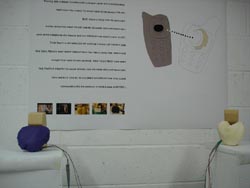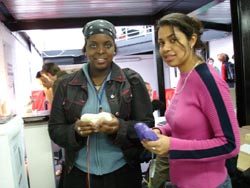

 subscribe
subscribeArduino Workshop
London (Paddington Art)
25 November 2005
The idea of an open-source hardware might sound strange, but that is exactly the intention of Massimo Banzi, David Cuartielles and David Mellis. The designers/programmers/mathemathicians (the list keeps going) wanted something simple but that could handle complex needs of new media creators and help in educational purposes. All of them where present in the London workshop, making it clear that the Arduino Klan was diverse, intense and, yes, fun.
"Evening Of The Reanimated Corpses is small 10 minute indie film done for a 'Mass Media' class and is going to be released under Perry Como Productions (a twilight zone reference). The film is a traditional zombie film and aims to have a heavy George Romero influence. Its releasy is planned for very early 2006. [...]
Have you heard the term Web 2.0 kicking about? Been wondering what the hell it means? Wikipedia (a Web 2.0 service in its own right) has a running definition:
A website could be said to be built using Web 2.0 technologies if it featured a number of the following techniques: CSS, semantically valid XHTML markup, and Microformats Unobtrusive Rich Application techniques (such as Ajax) Java Web Start. Flex/Laszlo/Flash, XUL, Syndication of data in RSS/Atom. Aggregation of RSS/Atom data. Clean and meaningful URLs. Support posting to a weblog REST or XML Webservice APIs...
In other words, it's everything you've already been doing, or should have been. Or is it?
In an article for Wired, Boing Boing's Xeni Jardin argues that a key component of 'Web 2.0' is 'public participation and contributions from the commons.' This, she says, is not necessarily a good thing. (Jardin is following here the recent invective from Nicholas Carr, who savages Wikipedia for innacuracy and Web 2.0 proponents for ' venerating the amateur' and 'distrusting the professional.'
(by christoph burgdorfer)
Timeframe: 2 to 5 years from now.
A couple of days ago, Google launched its new service "Google Reader" which is basically a RSS aggregator. I do not think, this is a coincidence. I believe that Google has realized that at some point, everybody will use his personal news feeds to get informed rather than just checking up a few news sources on a regular base. This will lead into a weakening of the current information sources' positions and support the possibility to get a wider variety and more independent opinions on topics of interest.
The way most of us read the news today has a long tradition. It originated in the 15th Century with the invention of the printing with movable letters by Johannes Gutenberg. Since then, the format has not much changed, we still get the newspapers printed out black on grey paper. At some point, there were pictures, then they became colorful, but let's face it, that doesn't make much of a difference, does it?
by Bruce Sterling
SIGGRAPH, Los Angeles, August 2004
The last speech at an awards ceremony can't be too short.
I'm Bruce Sterling, I'm a science fiction writer. I write novels. This is the first time I've ever been to SIGGRAPH. I always wanted to go.
My closet is full of old SIGGRAPH demo tapes. They're on VHS. I like to haul them out and play them for people at house parties. These are romantic icons of a lost world, these antique SIGGRAPH demo reels.
From Net Art News, Rhizome June 10, 2005
Kurating By Numbers
On the 4th of June, Tate Modern hosted the CURATING, IMMATERIALITY, SYSTEMS symposium to kick off its epochal Open Systems survey show of the conceptual and informatic art that swept the 1960s-70s. The conference acted as the first docking bay for UK-based programmer Grzesiek Sedek and curator Joasia Krysa's open source curating software KURATOR. Drawing on affinity between code art and curatorial praxis, the software tries to redevelop curating as a generative experiment in social relations, within and against an art world that is only beginning to bypass the genteel stultification of curator as the golden alibi of art markets and aesthete-at-large. KURATOR posits "software curating" as a way to distribute curatorial process over networks of people, including artists and others, and finally outwards from the special domain of an individual. It further combats the reification of taste by partially automating many of the traditional metiers that distinguish the curato! r - selectivity being one.


Tc/N Tactile communication is an interactive networked sculpture installation that allows people to communicate physical touch through the interface of heart, a physical input and output that has not been made exchangeable with current communication devices.The installation consists of two sides that communicate to each other over the internet.
The goal of the project is to make transportation of touch in networked communication possible, to remind people that natural physical input and output of human expression are essential key to communication, which may result in better and more sensational understanding of one another.
by Neal White
An introduction to the Critical Practices element of the Post graduate Departments. Writing and commentary aimed at stimulating debates and response for future publication.
What is missing?
Exformation and practice
In his essential work, especially for anyone wishing to study this area, Charlie Gere explores the advent and the development of issues relating to what he terms ‘Digital Culture’ . Gere explores the inter-relation of critical theory, technological and cultural discourse within the framework of a historical study. Successfully and articulately exploring the relationship between cybernetics, systems and information theory, cultural activity and the outcomes of digital media experiments in art and technology, we begin to get the message; that digital culture is less instrumental than it is a discourse set in relation to its own medium, that there is a relation between ideas embedded in technology and our cultural activities as a whole. But in examining the production and work at media arts festival, of media art and technology groups, of cultural producers, in the flesh, you would be forgiven for an experience in which you might ask; what is missing?